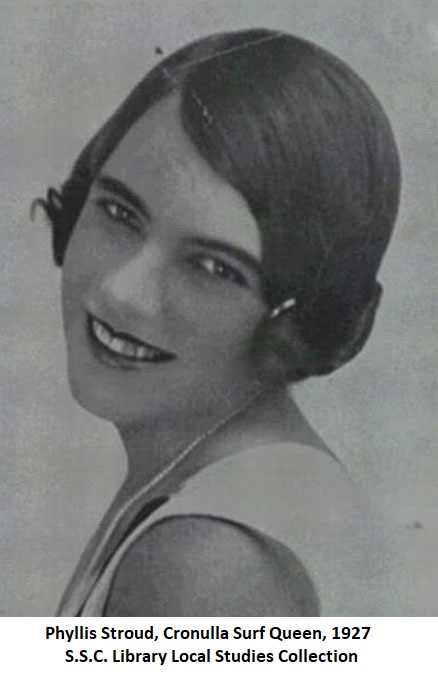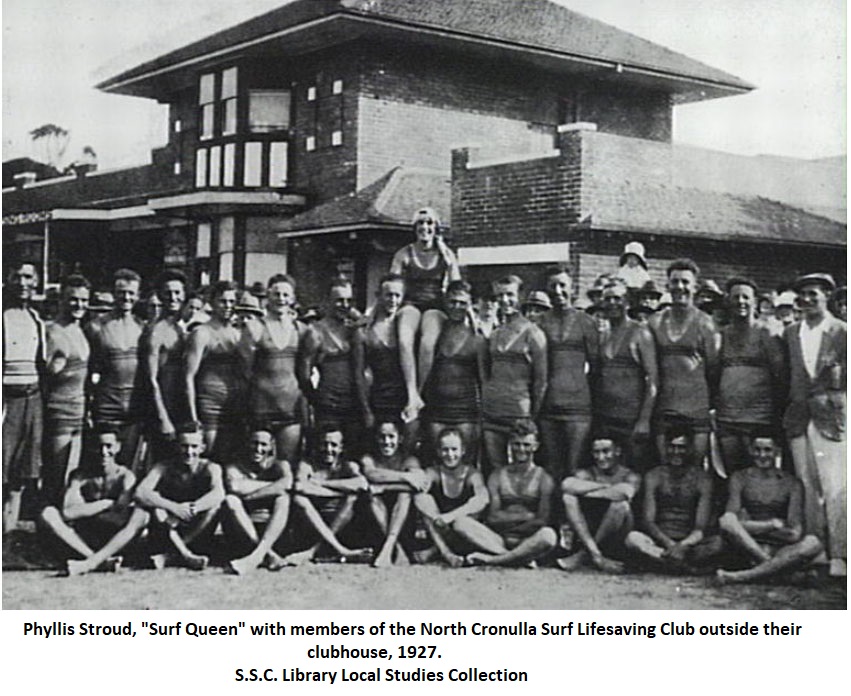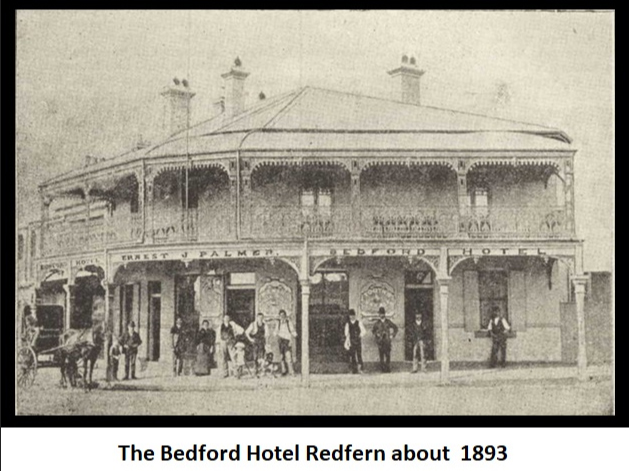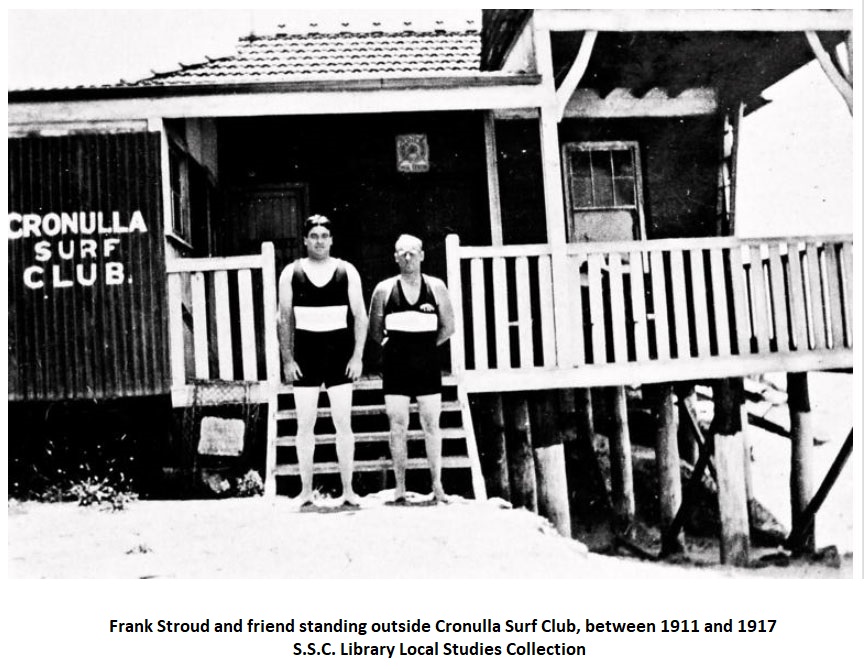

| Welcome | Database | Indexes | Copyright/Disclaimer | Login |
PHYLLIS STROUD (FARLEIGH) 1905-2011 and the STROUD FAMILY
 Cronulla
Surf Queen 1927
Cronulla
Surf Queen 1927
Phyllis Stroud
was chosen as Cronulla’s candidate for the Surf Queen competition of 1927. In
October 1926 The Sun newspaper in
Sydney launched The Queen of the Surf
competition to raise funds for surf life saving clubs and hospitals. Each
competitor needed the endorsement of a surf club to confirm she was a genuine
surfer but did not need to be a member of that club. Prize money of £475 would
be distributed among the clubs nominating the successful first, second and third
place getters with some other categories as well. The
Queen of the Surf was to be elected
by public vote, each vote costing a penny. The money thus raised would be
distributed among the hospitals.
Manly, Narrabeen, Bondi, Coogee, Maroubra
and fifteen other beaches, including Cronulla, set about choosing girls to
represent them.
First - Cronulla, 1,040,400 votes
Second – Clovelly, 1,026,924 votes
Third – Maroubra, 824,500 votes

On 26 January, 1927,
Anniversary Day, more than 100,000 people came to Cronulla for the crowning of
Phyllis Stroud as Queen of the Surf.
The ceremony was preceded by a procession which was more than a half mile
in length. It featured a brass band, decorated cars and lorries, Boy Scouts and
members of the surf clubs. There was a group of aborigines from Salt Pan with
Queen Warlunga, who was 75 years of age, having been born at Hungry Point, Kurra
Nulla (Cronulla). There was a large model of the ship
Renown manned by naval men. Queen
Phyllis appeared seated in a chaise drawn by four horses and attended by her
maids of honour. On the lawn near Cronulla Beach, attended by a crowd of court
officials and after a trumpet blast and reading of a proclamation, Queen Phyllis
was crowned by Councillor Monro, dressed as an Archbishop. This was followed by
presentation of prizes and the handing over of a cheque for £4,335 to N P
Neilson, President of the St George District Hospital.
Mr. Neilson thanked all who had been responsible and announced that Miss
Stroud and Miss Gurr (the Brighton Le-Sands candidate) had been made life
members of St George District Hospital.
After the coronation a flock of 2,000 pigeons was released and a shower
of flowers fell on the Queen.
The Strouds came
from families long associated with hotels in Sydney and licensed victuallers in
England. In interviews, Phyllis claimed that an uncle, John Palmer, established
the Bedford Hotel at Redfern and the Railway Parade Hotel at Kogarah when the
Illawarra rail line was opened in 1884.
John Palmer was born
in 1839, at Godstone, Surrey, the son of John Palmer and Mary Ann nee Shirley.
When baptised at St Mary’s Church at Horne, Surrey, his father was
described as a shoemaker. When Elizabeth Palmer, born in Godstone 1852, married
William Stroud in 1878, her father John Palmer was also described as a
shoemaker. It appears that John Palmer and Elizabeth Palmer were siblings
confirming Phyllis Strouds’ claim that John Palmer was her uncle. John Palmer
was also instrumental in establishing William Stroud as an hotelier in Kogarah.
John Palmer came to
Australia and in 1860, married Mary Hope.
Ann H. was born in 1861 and died in 1861.
Ernest John, born 12 July,1865 and Jessica, born 12 May, 1868 were
baptised at St Paul’s Church in Sydney on 31 May1868. Elizabeth was born in 1863
and twins, James and John in 1875. John died in
1875 and James in 1876. Mary Palmer died in 1876, aged 43.
In 1895, John Palmer
married Matilda Jane Carrick. He died on 26 February 1904, aged 64 and was
buried in the graveyard of St George’s Church, Hurstville. He was survived by
his wife, Matilda Jane, his daughters, Mrs Walter Smith, Mrs Norman Begg
(Jessica) and his sister, Mrs William Stroud (Elizabeth).
In 1881, a Publicans
Licence was issued to John Palmer for the Bedford Hotel at Wells and Rosehill
Streets, Redfern. This was a transfer of the licence
from Richard McNamara for the hotel formerly called the Darlington Inn and
renamed the Bedford by John Palmer. By 1896, the licence was held by John
Palmer’s son, Ernest John Palmer, who was Treasurer of the Licensed Victuallers
Association. The meetings of the Association were held at the Bedford Hotel. In
1888, Ernest John Palmer married Mary Isabella Hodges. His mother’s name, Hope,
was passed on to his two sons -- William Hope Palmer and John Stephen Hope
Palmer.

In February 1897
Ernest John Palmer died, aged 31. He was buried in the graveyard of St George’s
Church at Hurstville. When his
widow, Mary Isabella, nee Hodges, married James A Costello in 1897, the licence
reverted to John Palmer. The hotel was, for many years, known as Palmer’s Hotel.
The Stroud history
as hoteliers can be traced back to Francis Stroud born c1820 in Eltham, Kent. In
1842 he married Sophia White (1819-1886) in Canterbury, Kent, and then lived in
Westgate Without, in Canterbury, Kent, until his death in 1893.
Between 1842 and 1863 they had twelve children all born in Canterbury,
Kent.
In the 1841 England
Census, Francis and Sophia were working on the farm owned by William Collard. In
the 1851 Census, Francis is described as a dairyman and in 1861 as a labourer.
In 1871 and 1881 Francis is a licensed victualler and in the 1891 Census is
described as a publican. The pub is known as the Woolpack and in the 1881 Census
sons Francis, James and Edward are working for him as a baker, wine and spirit
porter and brewery cellarman respectively.
Sophia Stroud died
in 1886 and Francis Stroud died on 29 October, 1893. Probate on his property was
declared on 22 November, 1893.
William Stroud was
born on 1 July 1855 in Canterbury, Kent, England, the son of Francis Stroud and
his wife, Sophia, nee White. On 8 January, 1878, at St Andrew’s Church, West
Kensington, Hammersmith and Fulham, England, he married Elizabeth Palmer,
daughter of John and Mary Ann Palmer. William was described as a waiter.
On 15 April, 1879
their son William Frank John Stroud was born in Brighton, Sussex, England.
He was baptised at St. Nicholas’ Church, Brighton, on 17 August 1879. In
the 1881 Census, William, a waiter, and Elizabeth, a waitress, and their son,
William F.J. were living in Brighton. In 1883, a daughter, Florence Ethel was
born in Brighton, Sussex to William and Elizabeth Stroud.
In 1886, William
Stroud and his family arrived in Sydney on board the vessel
Garonne.
It is possible that they were encouraged to come to Australia by
Elizabeth’s brother, John Palmer as William soon became connected to hotels
associated with Palmer including the Woolpack Hotel in Redfern. In particular,
he lived in and held the Publicans’ Licence for the Railway Parade Hotel in
Kogarah from 1887. This would pass down after his death in 1905 to his wife
Elizabeth, and then to his son, Frank and become known as Stroud’s Hotel.
In her recorded interview held at Sutherland Library, Phyllis Farleigh
states that William Stroud died in Callan Park Asylum and his death was
registered at Balmain South which would support her claim. In his funeral
notices, his residence is identified as ‘Hastings’, Forest Road, Hurstville.
After a service at St George’s Church, Hurstville, William Stroud was buried at
Woronora Cemetery. In the Deceased
Estate Files he is described as a Licensed Victualler.
Elizabeth Stroud died in 1931. They were both buried in Woronora
Cemetery.
William Frank John Stroud (known as Frank) was born
on 1 April, 1879 in Brighton. Sussex, England, the son of William Stroud and his
wife, Elizabeth, nee Palmer. He was
baptised on 17 August 1879 in St. Nicholas’ Church in Brighton.
He is mentioned in the 1881 England Census living with his parents at 29
Borough Street, Brighton. In 1886,
he arrived in Sydney with his parents and sister Florence on the vessel
Garonne.
Frank Stroud was
educated at Kogarah Superior Public School and, at a testimonial function held
in 1913, when he retired from the Railway Parade Hotel, a former teacher, Mr.
James Murray, recalled how he had known him from boyhood when Frank was under
his scholastic care. He also
recalled the pride that followed his passing of the Junior University
examination in 1892. In reply,
Frank Stroud spoke of being ‘an old Kogarah boy’.
In the interview with Phyllis Farleigh, she states that her father went
to Windsor Grammar School but I could not find any verification to support this.
In the 1901 England
Census, Frank Stroud, age 21, is in Brighton, Sussex, England, working as a
barman for George Hammond, a licensed victualler, at the Stammer Park Hotel.
Also on the census is Violet Henrietta Hammond, age 19, the daughter of
George Hammond and his wife, Mary Amy.
In 1902, William
Frank John Stroud married Violet Henrietta Hammond in Brighton.
Their daughter, Violet Elizabeth Mary Stroud was born 1903 in Brighton.
In 1904, Frank Stroud returned to Sydney on the vessel
Suevic with his wife, Violet
Henrietta, and his infant daughter, Violet Elizabeth Mary.
As his father was
ill Frank moved in to assist his mother in the hotel. After the death of his
father William in 1904, Frank assumed the
management of the Railway Parade Hotel at Kogarah and lived there with his
family until 1913 when they moved to Cronulla.
During this period, Frank’s sister Florence married David Christian in 1906 died in 1971 and was buried in Woronora Cemetery. Florence and David also helped with the business and the children who were born in Kogarah:
Phyllis, born 1905, m. Raymond Farleigh at St. Mark’s Church, Darling Point on
14 August, 1930.
Audrey,
born 18 June, 1908, d.1931. Inquest 13 July, 1931.
Daphne, born 9 April, 1909 married George Huxtable 1934.
(Audrey and Daphne were baptised in St. Andrew’s Cathedral on 13 June, 1909.
John, born 27 September, 1912 was baptised in St.
Andrew’s Cathedral, on 1 December 1912.
Frank, born 28 May, 1918.
Their eldest child,
Violet Elizabeth Stroud m. Richard Lambie at All Saints Church, Woollahra, on 20
October, 1934.
After his return to
Kogarah in 1904, Frank Stroud was regularly swimming at Cronulla with a group of
men including Neville Cayley, Lance Giddings, Frank Statford, Joe Monro, William
Burns and others who were the founding members of the Cronulla Surf Life Saving
Club. Frank would become Club Captain and Chief Instructor and entertain the
Hawiian Duke Kahanomohu when he visited Cronulla in 1914 and demonstrated his
board riding skills at North Cronulla Beach to the amazed crowds.
During the 1914 -18 War, many of the members of Cronulla enlisted and
Frank Stroud took senior boys from Cronulla Public School, trained them for
their Bronze Medallions and kept the club operating.
He also trained the female members of the local VAD (Voluntary Aid
Detachment) in rescue and resuscitation methods. He was commended during this
time for rescues he had personally carried out.
On one occasion in 1917 Frank rescued two men and three women who had
been carried out in the surf. The family presented him with an engraved silver
teapot in appreciation. In 1919, Frank Stroud became the first recipient of Life
Membership of the Cronulla Surf Life Saving Club.

After 1920, Frank
Stroud returned to the hotel trade being associated with the Orange Grove Hotel
in Redfern, the Grand Central Hotel in Elizabeth Street in the city and the
Carlton Hotel in North Bondi. After
his retirement, the family lived in North Bondi.
Tragedy struck the family in July, 1931 when Audrey, aged 23, was
electrocuted by a trailing wire that had become detached from a pole during a
violent storm. Audrey was late reaching home so Frank was out looking for her
when he came upon the accident. In trying to move Audrey from the swinging wire
Frank was himself shocked. The incident was extensively reported in the Daily
Telegraph. Audrey was buried in
Woronora Cemetery.
William Frank John
Stroud died on 3 September, 1951 aged 72, as a result of an accident. He was
cremated and his ashes placed with his parents in Woronora Cemetery -- Anglican
Monumental, Section 1- 0019
Violet Henrietta
Stroud died 8 May, 1950. She was cremated and her ashes placed with her husband
in Woronora Cemetery.
William Stroud died
31 May, 1905 and was buried at Woronora Cemetery --
Anglican Monumental, Section 1-0019
Elizabeth Stroud
died 6 June, 1931 and was buried at Woronora Cemetery --
Anglican Monumental, Section 1- 0019
Audrey Stroud died 6
July, 1931 and was buried at Woronora Cemetery --
Anglican Monumental
Section 1 – 0020
Colleen Passfield
2018
Click on the name
PHYLLIS STROUD (FARLEIGH) 1905-2011 and the STROUD FAMILY at the heading
of this story. You will be taken to the database entry for Phyllis
and her family.
References:
Trove
NSW BDM
Ancestry
England Census
Sands Directory
NSW Electoral Rolls
Sutherland
Library/Oral History
Ryerson Index
Woronora Cemetery
The Cronulla Story –
(Cronulla SLSC) Gary Lester
Sydney Anglican
Parish Registers
Register of
Coroners’ Inquests, 1821-1937
Crew and Passenger
Lists, 1852-1930
Certificates for
Publicans’ Licenses, 1830-1849, 1853-1899